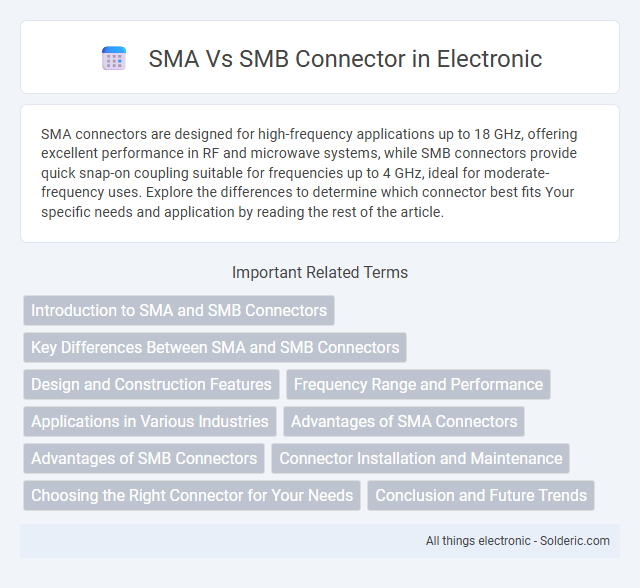SMA connectors are designed for high-frequency applications up to 18 GHz, offering excellent performance in RF and microwave systems, while SMB connectors provide quick snap-on coupling suitable for frequencies up to 4 GHz, ideal for moderate-frequency uses. Explore the differences to determine which connector best fits Your specific needs and application by reading the rest of the article.
Comparison Table
| Feature | SMA Connector | SMB Connector |
|---|---|---|
| Full Form | SubMiniature version A | SubMiniature version B |
| Frequency Range | Up to 18 GHz | Up to 4 GHz |
| Impedance | 50 Ohms | 50 Ohms |
| Size | Larger | Smaller, more compact |
| Connection Type | Screw-type coupling | Snap-on coupling |
| Durability | High mechanical stability | Moderate mechanical stability |
| Applications | RF and microwave systems, test equipment | Space-constrained RF systems |
| Cost | Generally higher | Generally lower |
Introduction to SMA and SMB Connectors
SMA connectors are precision RF connectors known for their threaded coupling mechanism, supporting frequencies up to 18 GHz, commonly used in microwave systems and antenna connections. SMB connectors feature a snap-on coupling design with quick connect and disconnect capability, operating effectively up to 4 GHz, often utilized in telecommunications and instrumentation applications. Both SMA and SMB connectors offer reliable performance in RF applications but differ significantly in size, coupling method, and frequency range.
Key Differences Between SMA and SMB Connectors
SMA connectors are threaded and provide a secure, high-frequency connection suitable for frequencies up to 18 GHz, whereas SMB connectors use a snap-on coupling design ideal for quick connections and frequencies up to 4 GHz. SMA connectors are commonly used in applications requiring robustness and minimal signal loss, such as RF and microwave systems, while SMB connectors excel in environments demanding easy installation and compact size, like telecommunications and test equipment. Your choice between SMA and SMB should consider frequency range, mechanical strength, and ease of use tailored to your specific device requirements.
Design and Construction Features
SMA connectors feature a threaded coupling mechanism ensuring secure, vibration-resistant connections ideal for high-frequency RF applications up to 18 GHz. SMB connectors utilize a snap-on coupling design for quick mating and demating, optimized for applications requiring fast installation but supporting frequencies up to 4 GHz. Your choice depends on whether you prioritize durability and precision in harsh environments (SMA) or convenience and speed in lower-frequency setups (SMB).
Frequency Range and Performance
SMA connectors typically support frequencies up to 18 GHz, making them suitable for high-frequency applications requiring low signal loss and excellent performance consistency. SMB connectors operate effectively up to 4 GHz, favoring compact designs with moderate frequency requirements and reliable signal transmission. The choice between SMA and SMB connectors depends on the application's frequency demands and performance criteria, with SMA preferred for higher frequency and precision environments.
Applications in Various Industries
SMA connectors are widely used in high-frequency applications such as telecommunications, aerospace, and military systems due to their excellent performance up to 18 GHz and robust design. SMB connectors, favored in automotive, medical devices, and wireless communication equipment, provide quick connect/disconnect capabilities with reliable performance up to 4 GHz. Both connector types enable efficient signal transmission in critical applications, but SMA is preferred for precision and high-frequency needs, while SMB suits compact and cost-effective solutions.
Advantages of SMA Connectors
SMA connectors offer superior frequency performance up to 18 GHz, making them ideal for high-frequency applications such as wireless communication and RF instrumentation. Their robust threaded coupling mechanism ensures secure and reliable connections, minimizing signal loss and maintaining consistent impedance. You benefit from enhanced durability and precision in signal transmission, especially in environments requiring stable and long-lasting RF connections.
Advantages of SMB Connectors
SMB connectors offer advantages such as snap-on coupling for quick and easy installation, making them ideal for applications requiring frequent connection and disconnection. They provide excellent vibration and shock resistance, enhancing reliability in automotive and mobile communication systems. Their compact size and lightweight design contribute to efficient use of space in high-density electronic assemblies.
Connector Installation and Maintenance
SMA connectors feature threaded coupling mechanisms that ensure secure, vibration-resistant connections ideal for outdoor and high-frequency applications, requiring careful torque application during installation to prevent damage. SMB connectors utilize snap-on coupling, enabling quick and easy installation without tools, making them suitable for devices needing frequent disconnections and compact spaces. Regular maintenance of SMA connectors involves inspecting threads for wear and ensuring cleanliness to maintain signal integrity, while SMB connectors benefit from routine checks for proper snap-fit engagement to avoid signal loss or intermittent connections.
Choosing the Right Connector for Your Needs
Choosing the right connector between SMA and SMB depends on factors such as frequency range, size constraints, and application requirements. SMA connectors offer excellent performance up to 18 GHz with high durability, making them ideal for precision RF and microwave applications. SMB connectors, being smaller and push-on style, suit compact devices requiring quick connections but typically support lower frequency ranges up to 4 GHz.
Conclusion and Future Trends
SMA connectors offer superior performance in high-frequency applications up to 18 GHz, while SMB connectors are preferred for compact designs requiring quick connect/disconnect functionality below 4 GHz. Future trends indicate increasing demand for miniaturized connectors with enhanced durability and improved broadband capabilities to support 5G and IoT devices. Your choice between SMA and SMB should consider frequency requirements, mechanical robustness, and evolving connectivity standards to optimize system performance.
SMA vs SMB Connector Infographic

 solderic.com
solderic.com